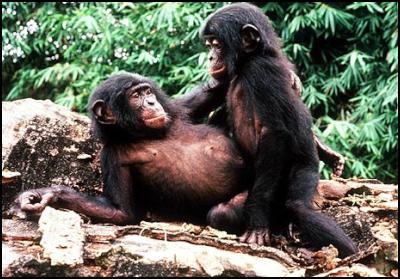Brainy Chimps, Part Two: Make Love, Not War?
by Martin LeFevreAlso see: Brainy Chimps (Part I)
Bonobos look like graceful versions of chimpanzees. They are entirely tree dwelling, don’t make tools and primitive war as chimpanzees do, or engage in hunting monkeys for meat.
“Bonobos have more style,” says Frans B. M. de Waal in a 1995 article in Scientific American, “Bonobo Sex and Society” They were one of the last large mammals to be discovered by science, and were at first thought to be juvenile chimps. However, though they belong to the same genus (Pan), they’re a distinct species (paniscus).
As much as chimpanzees, bonobos show the greatest capacity for self-awareness other than humans, being able to recognize themselves in mirrors and learn sign language.
The human primate, in its war on the planet, is wiping out the bonobos habitat in Zaire and threatening the 10,000 that are left on earth. Can we learn from them before its too late, or do they have little to teach us?
As de Waal states, “The bonobo species is best characterized as female-centered and egalitarian and as one that substitutes sex for aggression.”
With the possible exception of family members, “bonobos engage in sex in virtually every partner combination,” making them unlike chimps and more like humans. In dry scientific language, bonobos have “a partial separation between sex and reproduction,” which means they do it for other reasons than merely to make babies.
More importantly, from a feminist perspective, is the fact that despite the diminutive size of females as compared to males (called sexual dimorphism), bonobo females rule. Chimpanzees exhibit a kind of brutal male domination in the wild, whereas bonobo society is structured along matriarchal lines.
This is a key difference, not only between bonobo and chimp societies, but also between bonobo and most human societies. Since presumably humans aren’t as hard-wired as chimps, we could conceivably follow the bonobo model and have much more peaceful, egalitarian societies.
There is a trait that trumps gender difference however. Bonobos have “a far more sensitive temperament.” For example, during the World War II bombing of Munich, the bonobos in the Hellabrunn Zoo all died of fright from the noise, whereas the chimpanzees were unaffected. Which species most resembles humans?
There are some fascinating things involving the differences between bonobos and chimpanzees. How they apply to humans is an open question.
“Sex, it turns out, is the key to the social life of the bonobo,” states de Waal in the Scientific American article. Using sex in all forms to allay aggression, bonobos are the sole primate example of “Make love, not war.”
Chimps will often come together for a kiss and hug (literally) after a fight, but bonobos have sex before fights erupt, and before they share food. All kinds of sex: male initiating with female; female initiating with male; female ‘GG (genito-genitial) rubbing;’ male ‘penis fencing’ (read the article); and other interesting variations.
The most compelling fact about bonobo sex however is that they do it face to face. Chimps never do it that way, but bonobos do it face to face one out of three times in the wild--about the same as most marriages?
This behavior accompanies increased female sexual receptivity. Both male and female bonobos exhibit a high degree of tumescence of the genitals. That is, bonobo males get boners very easily (at the mere sight of food for example, not a trait Homo sap would want to imitate at a dinner party), and females get pink swelling that covers a much longer period of estrus. The average time of copulation among bonobos is 13 seconds, which gives new definition to premature ejaculation.
Bonobo society is not only female centered, but also female dominated. When a group of chimpanzees are presented with food, the typical male chimp will make a charging display, complete with dragging and swinging branches for effect, and claim everything for himself. With bonobos however, as de Waal states, “the male might make as many charging displays as he wanted; the females were not intimidated and ignored the commotion.”
Let’s cut to the chase. The bonobo lesson does not apply. In the West, we now have the worst male traits being embraced by both men and women. The best example is women being lauded for becoming ‘warriors’ alongside men in America’s invasions of Afghanistan and Iraq. Indeed, it can be argued that we now have a male-trait oriented, female dominated society.
In the Islamic world, the fear of men losing their domination is probably driving a lot of terrorist activity, since Muslim males have a dread of the desecration by Western culture of their pure images of womanhood.
Besides, we’re already like bonobos in the sense that “sex is partially separated from reproduction in our species because it serves to cement mutually profitable relationships between men and women.” How’s that workin’ out for us?
So, before feminists put forth the bonobo model for humans, they might want to consider that despite their quid pro quo (sex for food) arrangements, “the burden of raising offspring appears to rest entirely on the female’s shoulders.” Sound familiar?
“Nuclear families are probably incompatible with the diverse use of sex found in bonobos,” de Waal states in one of his few boners. Duh. In any case, in the West nuclear families are going the way of bonobos, which is leaving females to bear and raise children by themselves. That’s not good for anyone, especially children. Something has to give.
In the end, we humans can neither return to some Rousseauian past, nor appropriate models from primate cousins. We are where we are and have become what we have become. The way ahead is facing and remaining with what we are, which allows conscious transmutation to occur.
That’s a primate of a different persuasion altogether, beyond trivial sexual and gender differences.
Martin LeFevre is a contemplative and philosopher. More of his work and an archive can be found at the Colorado-based site Fountain of Light (fountainoflight.net). martinlefevre@sbcglobal.net




 DC Harding: In The Spirit Of Natural Justice
DC Harding: In The Spirit Of Natural Justice Martin LeFevre - Meditations: Animal Encounters During Meditative States
Martin LeFevre - Meditations: Animal Encounters During Meditative States Ian Powell: Gisborne Hospital Senior Doctors Strike Highlights Important Health System Issues
Ian Powell: Gisborne Hospital Senior Doctors Strike Highlights Important Health System Issues Keith Rankin: Who, Neither Politician Nor Monarch, Executed 100,000 Civilians In A Single Night?
Keith Rankin: Who, Neither Politician Nor Monarch, Executed 100,000 Civilians In A Single Night? Eugene Doyle: Writing In The Time Of Genocide
Eugene Doyle: Writing In The Time Of Genocide Gordon Campbell: On Wealth Taxes And Capital Flight
Gordon Campbell: On Wealth Taxes And Capital Flight